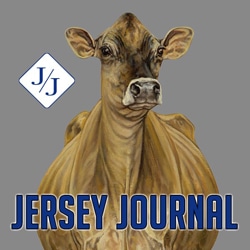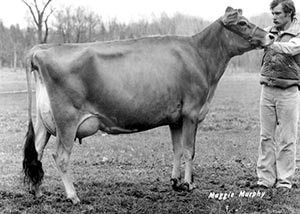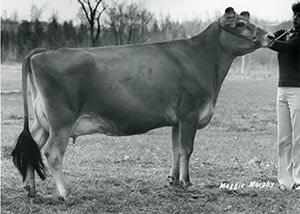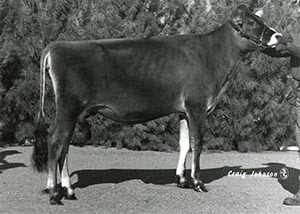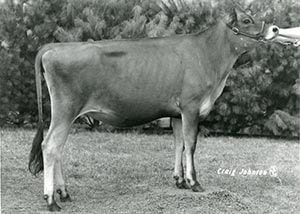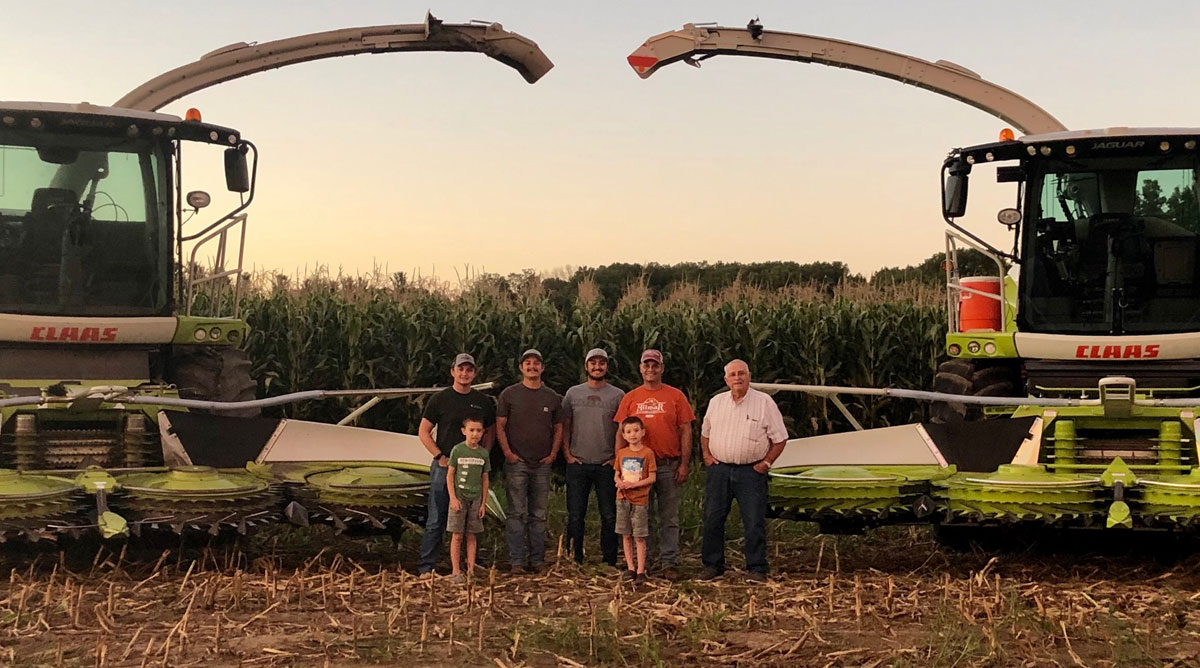Silver Spring Farm Jerseys Featured in Hoard’s Dairyman Judging Contest
Each year, dairy enthusiasts young and old look forward to the Hoard’s Dairyman Dairy Judging classes and seeing which breeder’s animals are showcased on the cover that year. Have you ever wondered what all goes into the making of the judging classes?
This past spring, the Charles Luchsinger Family of Silver Springs Farm, Syracuse, N.Y., represented the Jersey breed in this treasured and time-honored judging contest. Jersey Journal staff was glad to have the opportunity to talk to them about the process and their Registered Jersey herd.
Familiar to Jersey enthusiasts, Chuck’s family has owned and bred Jerseys since 1914 when his Swiss immigrant grandparents first purchased the home farm. After working for various herds nearby, including a Brown Swiss show herd, they knew they wanted to dairy farm on their own.

His grandparents were well known throughout the state and northeast for the quality cattle they raised. They raised registered animals that were milk tested and classified. Later, they would sell bulls, heifers and milking cows to interested parties. During all of this, they exhibited their cattle at various shows. In fact, the Luchsingers have a ribbon hanging at their home that is from the 1921 New York State Fair. Nearly 99-years ago and a legacy the family continues today.
Each of their seven children started a Jersey herd when they left home. While not all of them continued the passion, for various reasons, the love for the Jersey cow was clear in the Luchsinger family. Chuck’s father took over the farm post-war in 1950, which was when there was a push for more volume of milk. He increased herd size from 30 to 60-70 milking individuals.
Chuck took over the operation in 1986. Today, Chuck, his wife, Sue, and children, Charlie and Ali, are the last of the Luchsinger family to still operate a dairy operation. Chuck and Sue’s other daughter, Jennifer, operates Gordon Farms, with her husband, Josh, and his family in Indiana.
Over the years, the Luchsinger family has won numerous awards in the showring and been recognized for their breeding philosophies. In 2014, they were honored by the American Jersey Cattle Association as a Master Breeder. Chuck has held positions on both the AJCA and National All-Jersey Inc. board of directors, as well as has judged over 65 shows throughout his lifetime.
Recently, Jersey Journal staff sat down with Chuck Luchsinger to talk more about the family’s participation in the judging contest, their showring success and overall farm operation. Read below his answers to the questions.
What is involved in the selection process to have your herd represent the Jersey breed in the Hoard’s Dairyman Judging Contest?
The decision is up to Corey Geiger, Mukwonago, Wis., from Hoard’s Dairyman. It’s not something you apply for, he just selects your herd based on reputation, what you’ve done recently, breed activities, etc. We have been around a long time, so he just got around to picking us.
We actually did it one other time back in the 1970s, I believe 1976 or 1977.
Walk us through the process once you were selected.
Corey first contacted us in the fall of 2018. In the spring of 2019, a year before the contest, he visited the farm and walked through the herd with us. Obviously, we showed him some of the better cows. He took down their names and numbers, I think there ended up being seven or eight individuals. This is about how many individuals Corey said that he likes to have in order to narrow it down to four for the contest.
The next step was having Kathy DeBruin, New Glarus, Wis., from Agri-Graphics come and picture the animals that summer. She has actually been picturing the animals for the contest for the last 30 years. When Kathy came up later that summer, I believe we pictured five cows. We decided to wait and have her come back that fall to picture a few more, as they would be in better condition at that point.
When she came back the second time, it was shortly after the New York State Fair. She came with the intent of picturing two animals, but we only did one. The other came back from the show and was just off and having a bad day. She didn’t feel good, didn’t udder up, so we all agreed it wouldn’t do her justice to take her picture that day. She’s probably the best cow, the cow that would have won the contest, but we didn’t even picture her.
Overall, this process started about a year and a half from the point of Corey initially contacting us to when the issues were released this past spring.
How did you choose the cows?
As far as age groups, you want to have cows that are mature and calved at least two or three times. All of our cows in the contest had three lactations or more. We focused on middle aged cows that look good, have good rear udders, were in good dairy form and a bit more on the stylish side. It also helps to have productive cows with good udders.
Tell us about the four cows in the contest.
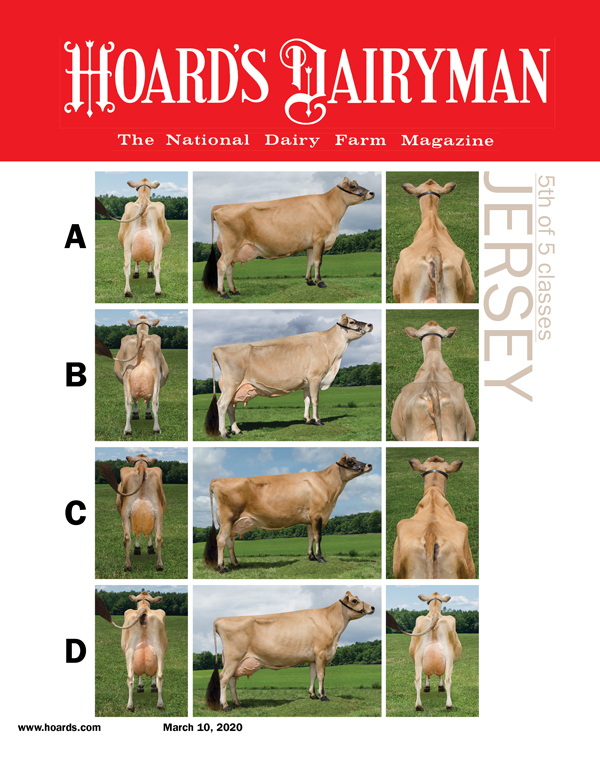
Cow A – SSF Incentive Cheerful – Excellent-94%
AAA 2-00 305 17326 – 923 – 612 – 2115C
AAA 3-05 259 18147 – 924 – 659 – 2279C
AAA 4-04 305 19017 – 1055 – 668 – 2309C
AAA 305 2X ME AVG 3 Lact. = 18,163M – 967F – 646P – 2,234C
Cow A is a daughter of Hometown Incentive-ET, GJPI -159, who is a Tequila from Huronia Connectn Crystalyn 23L, SUP-EX-95%. In July, she was raised to Excellent-94% from 92. She’s been a really good cow for us and is milking close to 90 lbs. each day right now.
She’s a very well-balanced cow and looked very good in the contest. I had a few individuals comment that she actually had the most breed character than the other ones in the contest.
Cow B – SSF Bellevue Blossom – Excellent-94%
AAA 5-06 305 18,880 – 1,040 – 632 – 2,183C
AAA 6-07 259 16,680 – 754 – 544 – 1,878C
AAA 7-06 305 18,595 – 813 – 644 – 2,192C
AAA 305 2X ME AVG 6 Lact. = 16,839M – 871F – 549P – 2,048C
The B cow is an Excellent-94% daughter of one of our homebred bulls, Silver Spring Bellevue-ET. He’s a son of Sunset Canyon Ren Belle, the All American Senior Two-Year-Old from 2003. B’s dam is an Excellent-94% Jade daughter who just celebrated her 15th birthday here on the farm.
Blossom just turned nine-years-old this year and is a large, huge framed cow. She’s made a great record and has produced well over 100,000 lbs. of milk. She’s a member of the best cow family we have in the herd and has three Excellent sisters.
Cow C – SSF Boeheim Deanine – Excellent-93%
AAA 3-09 305 20,571 – 883 – 727 – 2,420C
AAA 5-00 283 18,254 – 789 – 653 – 2,168C
AAA 5-11 305 22,187 – 889 – 755 – 2,467C
AAA 305 2X ME AVG 4 Lact. = 19,996M – 851F – 708P – 2,342C
Cow C is eight-years-old and a real barn favorite here. This cow has the end stall and everyone asks, “Who is that cow,” when they walk in the barn. She’s a daughter of another homebred bull, SSF Glasgow Boeheim (maternal brother to Cow B), who my son named after the basketball coach. “Boeheim” has done an excellent job, he’s given us a lot of Excellent daughters.
Deanine’s dam was an “On Time” that we lost as a two-year-old. She’s just a real long, rangy cow with a great udder. She’s had really good records and we’ve even shown her a couple times. Again, she’s just a barn favorite.
Cow D – SSF Redpath Candy – Excellent-92%
AAA 3-00 305 23,532 – 1,050 – 754 – 2,602C
AAA 4-03 305 17,340 – 784 – 624 – 2,119C
AAA 5-04 305 20,010 – 1,087 – 694 – 2,398C
AAA 305 2X ME AVG 4 Lact. = 18,639M – 903F – 644P – 2,214C
A daughter of Rapid Bay Redpath, a bull we didn’t have much luck with in the herd, Cow D is the one we had the most luck with. She’s currently milking around 80 lbs. and is one of the highest producers in the barn. She recently turned seven-years-old.
She seemed to fit the other ones in the class. She did end up placing on the bottom, but she’s got all good points about her. We did show her one time, she did respectable about three or four years ago.
Loaded, but hopefully fun question. Did the family place them the same as the judge?
*Upon asking the question, there was immediate laughter from Chuck’s wife, Sue.*
We did not fill anything out, as we were ineligible to complete. We just kind of talked about them among ourselves. When Charlie, Ali, Sue and I looked at them, we had them pretty much figured.
First of all, I think Jenny Thomas, Triple-T Holsteins and Jerseys, North Lewisburg, Ohio, did an excellent job of placing them and describing her placings. The ‘B’ cow just seemed to have all the parts that were just a little bit better than the other cows. She was deeper ribbed, higher and wider in the rear udder and looks more mature and powerful. Jenny’s description of her fit her perfectly. On down the line, I certainly agree with her. As far as the photos looked, I think she did a great job and I agreed you had to go that way.
Before I saw the official placings, I was kind of back and forth on B and C. I think for anyone looking at the photos, the B cow seemed to out measure some of the other cows in almost every respect. I was thinking that if someone is going to judge these based on the pictures, they probably have to go with the B cow.
But, I still liked the ‘C’ cow. She had the ‘C’ cow second, but I like her better than B. But that’s because I see them every day. This is just a quick snapshot of what they looked like when they pictured them. The only thing the C cow lacks that B doesn’t is that she isn’t as deep through her fore and rear rib. But she’s got a better fore udder and she’s longer in the neck. Based on that, I think she was just a little more stylish than the B cow.
It is kind of a fun thing. I don’t know if a lot of other herd owners would actually admit they saw it a different way. It’s kind of a yes and no thing. Yes, I think Jenny got it right based on the photos. For me, I see them every day.
Actually right now, I think the A cow is the best. But that’s a year later. She really looked good when we scored in early July. The B cow is dry and due in September. The other two are mid-lactation.
*Sue also commented on this question and said, “Some of us judged the cows on how we like them. Others judged the cows on how they pictured. We kind of knew what was going to happen from the picture, how they were going to place, but we like the other cow better.
Your family has shown cattle for many, many years – what are some of your most fond memories?
There’s a lot of them. This is like asking a professional athlete what his favorite game was. In fact, we have a ribbon from the New York State Fair dated 1921. That’s when my grandfather started showing, over 99 years ago. We’ve been showing a long time.
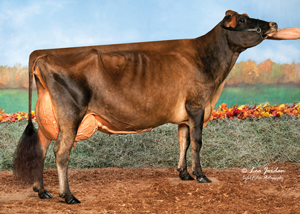
We’ve won classes at the All American, bred a National Champion, and had champions at the Royal Winter Fair and Eastern States Expositions. During our glory years of the 70s, 80s and 90s, we did and have done a lot of things.
However, for me, I think it was last fall at the New York State Fair in September when our cow, SSF Boeheim Pace, Excellent-94% (pictured left), was named Supreme Champion. This award is selected by a group of about seven respected owners and herdsmen. They sit down and have a meeting after all the shows are complete and they vote on the award. To have that group of people pick our cow was great. There were a lot of good cows of other breeds there.
During the Supreme Champion meeting, every exhibitor in the barn is there at ringside. When the dairy cattle superintendent announced ours.. *long pause*.. that was probably my most memorable moment. “Pace” went on to place third in a competitive class at the All American later that fall. She’s a sister to the ‘C’ cow in the contest and is due to calve again in December.
Other Highlights
Another great time for our family was the National Jersey Jug Futurity in 1978. We not only won, but had first, second and fourth. That was a pretty neat highlight. They all three were sired by the same bull.
|
Faithful Flora of SSF, VG-86% 1978 National Jersey Jug Futurity Winner
|
Faithful Golden Eleanor of SSF, VG-84% 1978 National Jersey Jug Futurity Reserve Winner
|
Another highlight that I can remember being pretty proud of was in 1996. That year we had the National Junior Champion, SSF Juno Bell, Excellent-90%, at the All American and bred the Reserve Junior Champion. I don’t think that anyone else has done that since. The heifer that was reserve, SSF Jude Sparkle, Excellent-90%, we put her into a sale and the Bachelor family from Indiana purchased her.
|
SSF Juno Bell, EX-90% 1996 National Junior Champion
|
SSF Jude Sparkle, EX-90% 1996 Reserve National Junior Champion
|
Another one that was kind of a real surprise – well not really because we knew she was pretty good – but in 1976 we had a daughter of the old H.V.F Pacesetter bull, Pacesetter Keeb-A-Loop of SSF, Excellent-93%. We brought her up to the Royal Winter Fair. At that time, us, Happy Valley and Pioneer were the only American herds that went up there. We kind of kept her under wraps and didn’t say a whole lot about her.
She ended up winning the futurity up there. Then she had everyone’s attention. Two days later, she was champion of the open show. That was a real highlight for us. She was one of our first champions at a bigger show. This will bring back some memories for some of the old people. Wait until Ronnie Moser sees that.
Can you provide some comments about how exhibiting cattle has changed over the years?
Some people may look at the highlights and wonder, “Don’t you have any more recent ones?” Over the years, things have changed. It’s so much more difficult now to get in and win a big class at a larger show. There are so many specialized cows out there now.
They’re cows that originate on a farm somewhere and show real promise. Then people that go around and look for these types of cows. Once they spot them or hear about them, they buy and develop them into a show cow. They will come out and win and then maybe sell again for a lot of money. That’s something that happens nowadays that didn’t happen nearly as much before.
For breeders like us, to compete with some of those cows who get 365-day show care and development is really difficult. We are just a dairy farm trying to make end’s meet. We can’t give them that kind of care.
If you look at a lot of the winners and champions from the larger shows, like the All American or the Royal, that’s kind of what a lot of their history is. Something like that or similar. I don’t know if a lot of people understand that, but from my perspective, that’s what’s happening now. I think a lot of people would agree with me.
This doesn’t stop people from coming out to the shows. The numbers are still there. What’s really gratifying is to see the junior shows as big as they are. People my age aren’t going to be around forever. It seems there’s enough juniors that are just crazy over showing cattle. It’s going to be like that a long time.
In addition to the farm, your family runs the farm market. Can you please tell us more about that?
For the past 21 years, we have operated a farm market, Silver Spring Farm Market, that is a bit closer to Syracuse. We’re open from May to December and our biggest commodity there is flowers, hanging baskets and plants. In the summer we also sell produce, fall is mums and pumpkins and then Christmas trees in winter.
When we bought it years ago, we happened to have a good year for milk prices and had sold some cattle. The couple that owned it was older and wanted to retire and move back up north. It came up for sale and there were a couple other farms looking at it. I guess we were the only ones who could come up with the down payment though because we were the ones who were able to purchase it.
It was very lucrative the first two or three years, then other people saw us doing it and two other places sprung up down the road. Then big stores like Lowes, Walmart and Home Depot started selling flowers. The competition with these operations cut into us with both margins and volumes. So we’ve been breaking even and paying the expenses over the years. But it’s been something Sue’s always wanted to do.
This year was by far the best year we have ever had. With the COVID crisis, people were staying home, taking care of their gardens, planting vegetables. Our parking lot wasn’t big enough this year. It was one of the few things that, for us, COVID was really helpful.
We never expected that but it happened. Our competitors down the road said the same things. I don’t think people wanted to go to the larger stores. Instead they came to the local places and supported us. Hopefully they may realize, they want to do that next year too and people’s habits will change. People wanted to drink more milk because they stayed home. I hope that continues happening.
Describe your farm setup, facilities, crops, etc.
Our farm consists of 200 owned acres and an additional 100 rented. We milk about 100 cows and then have the appropriate number of replacements for these animals. Our cows are milked in a tie stall barn.
I think our herd looks really good right now. We had eight new Excellent cows this past appraisal, almost half our herd is Excellent. I noticed on our appraisal print out that they give the average appraisal score of all your cows and ours is 88. That was exciting.
We used to milk more; the barn holds 110 cows. But we have had to streamline. Our new milk processor offers a big quality premium. So, we are focusing even more on quality now.
Calves are raised in hutches while on milk, then moved into an enclosed, well-ventilated calf barn until they’re about six months old. After that until close to calving, they’re in a heifer freestall and either bred with a young bull we have here or with artificial insemination.
Our son, Charlie, is on the farm with me full-time. Our daughter, Ali, comes to the farm to help with operations six days a week and then goes to her fulltime career at a local bank. Sue runs the farm market. Our other daughter, Jenny, lives in Indiana now but still owns several head here. She visits us a few times each year with her husband, Josh Gordon, and their four children.
I think we’re typical of other Jersey herd sin the country where they’ve been in business for a long time, multi-generational herds. We are content with our size. In the surrounding area and our county, there’s probably a handful, if that, of herds left our size, some even smaller. I think it’s typical for a lot of reasons in the country that things have evolved this way.
We have had to struggle, like a lot of herds will tell you they do, especially the last four years. But we are still in business. I believe having Jerseys is really what sets us apart from some of the herds that have gone. With the high components and other advantages Jerseys have, I’m really happy we have them and have for such a long time.
It gives us a profile similar to other herds around the country. We talked earlier how a lot of the top show cattle become top show cattle. We’re one of many herds that just hope to have some like that. We have sold two cows this year, so we’re still making those kind. It’s just a matter of finding them and getting them into the right stream.
Most of this stuff is ancient history, but it happened. We will never forget it. We’ve been involved with shows for a such a long time, my whole life really.
